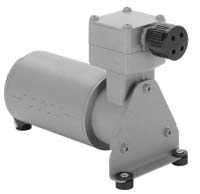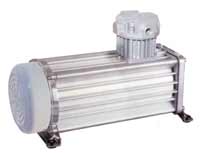| THE COMPRESSOR AND THE PRESSURE SWITCH: |
 |
As I said earlier, the compressor's sole purpose in life is to keep the tank full. It does this via a pressure switch. The switch is mounted between the compressor and the tank. It has a pressure 'window' that opens or closes the contacts of the switch. I use a 110-145psi switch. That means when pressure is below 145psi, the switch is closed, causing the compressor to run. When pressure reaches 145psi, it opens and turns off the compressor. The 110psi is the lower limit where the switch will close again and activate the compressor. For example, you wouldn't want the pump(s) to come on every time the pressure dropped to 139psi. The 110 limit is there to make it practical. The compressor pictured to the left is a Thomas 317. It is rated at 150psi and can draw 20 amps. It should only run for 5 minutes at a time with a 20 minute rest period between each five minute interval. |
 |
This particular switch is a 110-145 unit that AirLift sells for $20. It has a pipe thread on it so it can be plumbed into your system via a T. Be sure to use a relay with this switch. It will prolong the life of the switch considerably. |
|
There's
really no comparison between the two, a belt driven unit is much more capable
of filling high capacity tanks to higher psi levels than an everyday 12V electric
compressor. The way to go is belt driven, but for many reasons a belt driven unit
is not always practical. In terms of cost, the electric units needed to supply
the same amount of air as a large York compressor makes the belt driven York a
better deal, espcially since the added strain of the pumps would tax the electrical
system pretty hard.
|

York Belt Driven Compressor |
|
As
a benefit to the elctric compressors, they are relatively cheap ($100-$200) and
can do the job of airing the vehicle up and down fairly easily if not abused.
The problem with electric compressors is the 'recovery' time, or the amount of
time it takes to bring the tanks back up to the high pressure limit after airing
up the vehicle from a deflated state. This will usually take 1-2 minutes depending
on the application. The amount of air reserves and pressure level are also weak
points for the electrics. Since it can olny fill the tanks at a certain speed,
the capacity of the tanks and/or pressure level have to be reduced. A belt driven
unit can fill a bigger tank to higher pressure levels and therefore give you extra
'play' time.
|
 100% Duty Cycle, 3/4HP |
| Pictured above and to the right is one of the more capable electric units. It isa 100% duty cycle, 3/4 horsepower unit that sells for around $400. A typical electric configuration would be to run two pumps and five gallons of air off a 110/145psi switch. Belt driven pumps can double or even triple the capacity and pressure ratings to give you more freedom when it comes time to airing the vehicle up and down. For each electric pump, you should have no more than 5 gallons of air, the more reserves you have, the longer the pumps have to run to re-pressurize the tank. |
|
|
|
|
|
|
|
|
|
| 1)
Higher pressure levels 2) Larger air reserve capacity 3) 100% duty cycle 4) Quick refill time 5) Additional 'clown' time 6) Low current draw 7) Faster Air System 8) Overall higher quality pump |
1)
More expensive than a single electric set-up 2) Mounting brackets and hardware are necessary 3) Large size 4) Nowhere to mount unit 5) Decreased engine HP 6) Some require oiling 7) Plumbing can be more difficult |
|
|
|
|
|
|
|
|
|
| 1)
Inexpensive 2) Easily mounted 3) Simple to install 4) Adequate for function based systems 5) Does not rob HP. |
1)
Slow recovery time 2) Noisy 3) Less reserve air 4) Lower pressure levels 5) Increased load on charging system. 6) Lower duty cycle on inexpensive units 7) Overall lower quality pump |
| I felt this was at least worth mentioning even though my experience with anything other than the Lincoln Mark VIII pump is limited. That being said, the only pump I can recommend for use on a fast bag air suspension is the Lincoln Mark VIII pump. These cars were made from 1993-1998 and are standard equipment on every Mark VIII sold. The earlier Lincoln pumps will not work and I have been informed that the Cadillac pumps do not work very well either. You can get a remanufactured Mark VIII pump from Blue Collar Industries for $150. I have been using one in my system for over a year now and it has held up to the abuse just fine. |